Guitar tablature, most commonly known as “guitar tabs,” is a revolutionary system of music notation that makes learning guitar accessible to everyone, especially beginners. Forget struggling with traditional sheet music right away; guitar tabs offer a straightforward path to playing your favorite songs quickly. While sharing some similarities with standard music notation by indicating notes, rhythm, and techniques, guitar tabs have a distinct advantage for guitarists: they show you exactly where to play those notes on the fretboard.
This is incredibly helpful because, unlike a piano, the guitar allows you to play the same note in multiple locations. Understanding guitar tabs and learning how to read them unlocks a world of musical possibilities, allowing you to learn guitar even without prior knowledge of traditional musical notation.
At guitarplayers.net, we champion guitar tabs as a fundamental learning tool. Guitar tabs are versatile, displaying both chords and single notes, making them the quickest route to mastering songs you love. The beauty of guitar tabs lies in their simplicity. No prior musical expertise is needed – just a basic understanding of your guitar strings and frets, and you’re ready to go.
If you’re eager to demystify guitar tabs and explore their potential, you’ve landed in the perfect spot. Let’s dive in and discover the world of guitar tablature.
WHAT ARE GUITAR TABS?
Guitar tablature is essentially a visual map of music for guitarists. Think of it as a guitar-specific language for reading songs. A standard guitar tab is composed of six horizontal lines, each representing one of the six strings on your guitar. When you look at a guitar tab, you read it from top to bottom, just like you would read standard text. The topmost line corresponds to the high E string (the thinnest string), followed by lines representing the B, G, D, A, and low E strings (the thickest string) as you move downwards.
This arrangement mirrors how you see your guitar strings when you’re holding the instrument in playing position. Therefore, envision guitar tablature as your personal roadmap to musical fluency on the guitar, guiding you on the fastest route to playing your favorite tunes.
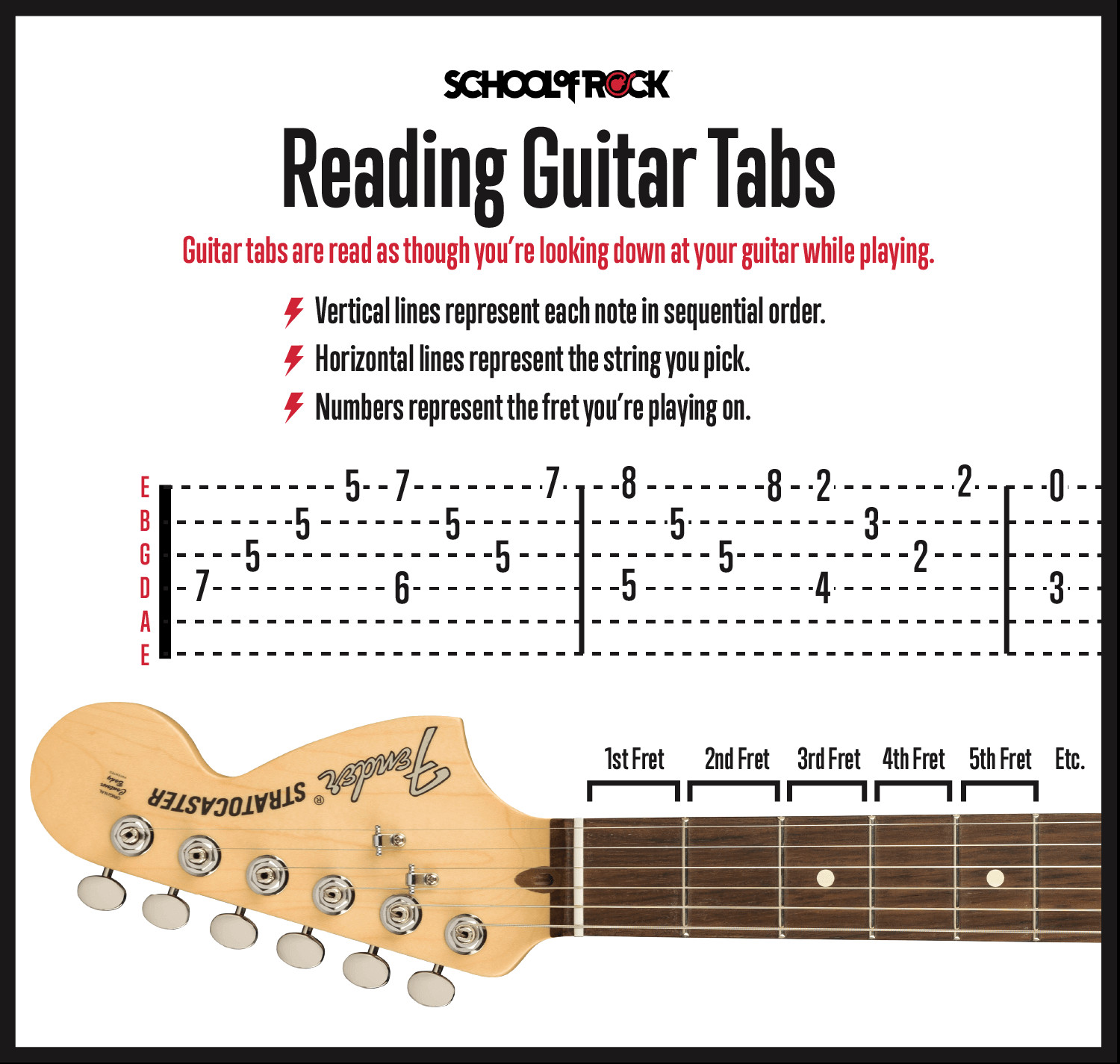 Reading guitar tabs
Reading guitar tabs
Within the guitar tab, you’ll notice numbers placed on these lines. These numbers represent the frets on your guitar neck – those metal strips that run across the fretboard. Frets are numbered from 0 to upwards of 20+ (depending on your guitar), starting from the nut (the piece closest to the headstock) and extending down the neck.
A “0” on a string line signifies playing that string “open,” meaning you pluck or pick the string without pressing down any frets with your fretting hand. If you see a “1,” it means you should play the note at the first fret on that string. Crucially, when learning how to read guitar tabs, remember that “1” always refers to the first fret, “2” to the second fret, “3” to the third fret, and so on.
HOW TO READ GUITAR TABS: A Step-by-Step Guide
Reading guitar tablature is intuitive and follows a left-to-right direction, just like reading a book. The notes in a tab are presented in the order they are played in the song. When you see numbers stacked vertically on top of each other across multiple lines, it indicates a chord. A chord is played by strumming all the strings indicated simultaneously. Guitar tabs are particularly beginner-friendly compared to standard notation because they clearly show you both the notes that constitute a chord and where to find them on your guitar fretboard.
Essential Knowledge for Reading Guitar Tabs
To successfully read guitar tabs as a beginner, the primary requirements are familiarity with the names and order of the 6 guitar strings and an understanding of the fret positions on your guitar neck. This basic knowledge allows you to translate the numbers on the tab into physical positions on your instrument, guiding you to play the correct notes.
Decoding the Guitar Tab Staff
The guitar tab staff visually resembles the staff used in standard musical notation, which can be initially confusing. However, a key difference is that the lines in a guitar tab staff represent the 6 guitar strings, not musical pitches like in standard notation.
As mentioned earlier, the top line represents the high E string, and the bottom line corresponds to the low E string. This direct representation of the guitar strings makes learning how to read guitar tabs significantly easier for beginners. Typically, a guitar tab staff will also be labeled “TAB” to prevent confusion with standard notation.
Understanding Guitar Frets in Tabs
Guitar frets, the metal strips spanning your fretboard, are the numerical indicators in guitar tabs.
Most guitars feature between 19 and 24 frets. Each fret represents a semitone or half-step interval in pitch from the adjacent fret. Within each octave, there are 12 semitones (or frets). Many guitars have fret markers, often dots or inlays, positioned at the 3rd, 5th, 7th, 9th, and 12th frets. These markers are visual aids to quickly identify fret positions while playing.
Remember the number “0” in a tab signifies an open string. Numbers 1 and above indicate the fret number to be played on that string. Playing an open string simply involves picking or plucking the string without fretting any note.
Reading Guitar Tab Chords
Guitar chords in tabs don’t have unique symbols but are easily identifiable by their vertical arrangement. When you see multiple numbers aligned vertically in a tab, it signifies a chord where all those notes are played together simultaneously. If a chord is arpeggiated (played one note at a time), it will appear as a sequence of single notes in the tab, even though you are still fretting the chord shape.
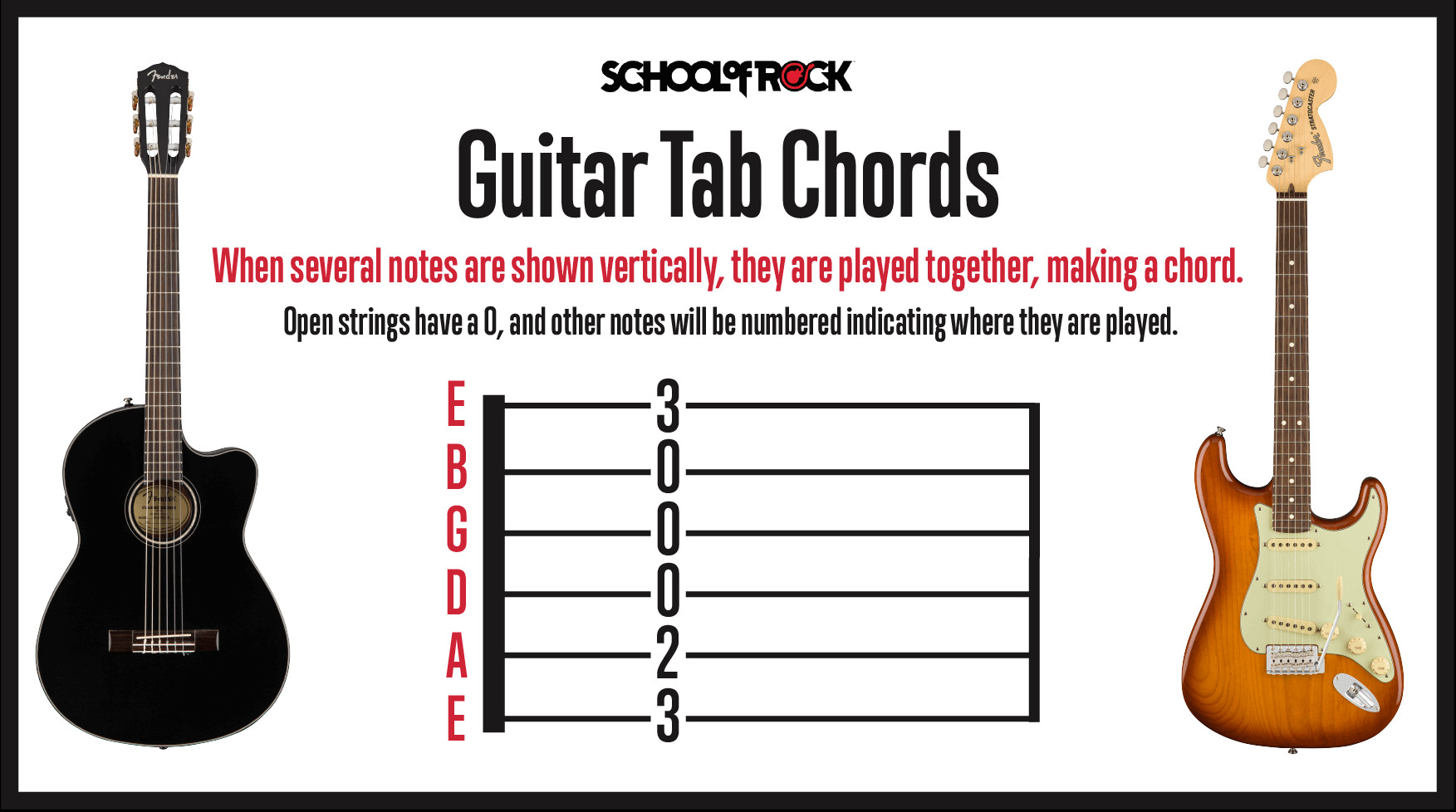 How to read guitar tab chords
How to read guitar tab chords
Understanding Guitar Tab Riffs
Riffs, common in rock and many other genres, are short, repeated musical phrases. They often combine single notes and partial chords, such as power chords. When reading riffs in guitar tabs, the same principle applies: vertically aligned notes are played together. This consistency makes learning to read guitar tablature for riffs straightforward.
Guitar Tabs vs. Chord Charts: What’s the Difference?
Guitar tabs and chord charts serve different but complementary purposes. A chord chart is a visual diagram illustrating where to place your fingers on the fretboard to form a specific chord. It often includes finger numbers to guide your hand positioning. Chord charts are frequently placed above song lyrics to indicate chord changes.
However, chord charts simplify chords to their essential 3 or 4 notes. A full guitar arrangement may include single notes, notes outside the basic chord, or arpeggios, which chord charts don’t capture. Therefore, guitar tabs often accompany chord charts, especially for beginners, to provide a more complete picture of how to play a song beyond basic chord strumming.
Finger Numbers in Chord Charts (Not Tabs)
Chord charts use a numbering system to indicate finger placement, unlike guitar tabs which use numbers for frets. In chord charts, the fingers of your fretting hand are numbered: 1 for index, 2 for middle, 3 for ring, and 4 for pinky.
Guitar tabs, in contrast, use numbers exclusively to represent frets, not fingers. For this reason, chord charts are often included alongside beginner-friendly guitar tabs to guide hand positioning and finger usage for chords.
Play Guitar in Real Performances Onstage
Our music programs are led by experienced, practicing musicians dedicated to helping you learn to play effectively. Gain performance experience and hone your guitar skills in a supportive environment tailored for all levels.
Decoding Guitar Tab Symbols: Techniques Beyond the Notes
Beyond numbers and lines, guitar tabs utilize symbols to represent various guitar techniques that add character and expression to your playing. Understanding these symbols is crucial for authentic and nuanced performance when reading guitar tabs.
Before you start playing, always ensure your guitar is correctly tuned. Refer to a guitar tuning guide if needed, as proper tuning is fundamental to accurate sound.
Muting Guitar Notes: Adding Dynamics and Style
Muting is a vital guitar technique, especially in genres like rock, metal, punk, and alternative music. Muting techniques add rhythmic articulation and sonic texture.
How to Master Guitar Muting
Muting can be achieved with either your picking hand, your fretting hand, or a combination of both. It introduces dynamics to your playing, differentiating verses from choruses or adding rhythmic drive. Experienced guitarists often employ muting instinctively to control unwanted noise and feedback, especially at higher volumes.
Palm Muting Technique in Guitar Tabs
Palm muting is a cornerstone technique in rock guitar. It involves lightly resting the palm of your picking hand on the strings near the bridge while picking. Heavy palm muting creates a tight, percussive sound, while lighter palm muting allows notes to sustain more. In guitar tabs, palm muting is typically indicated by “P.M.” above the section where it should be applied.
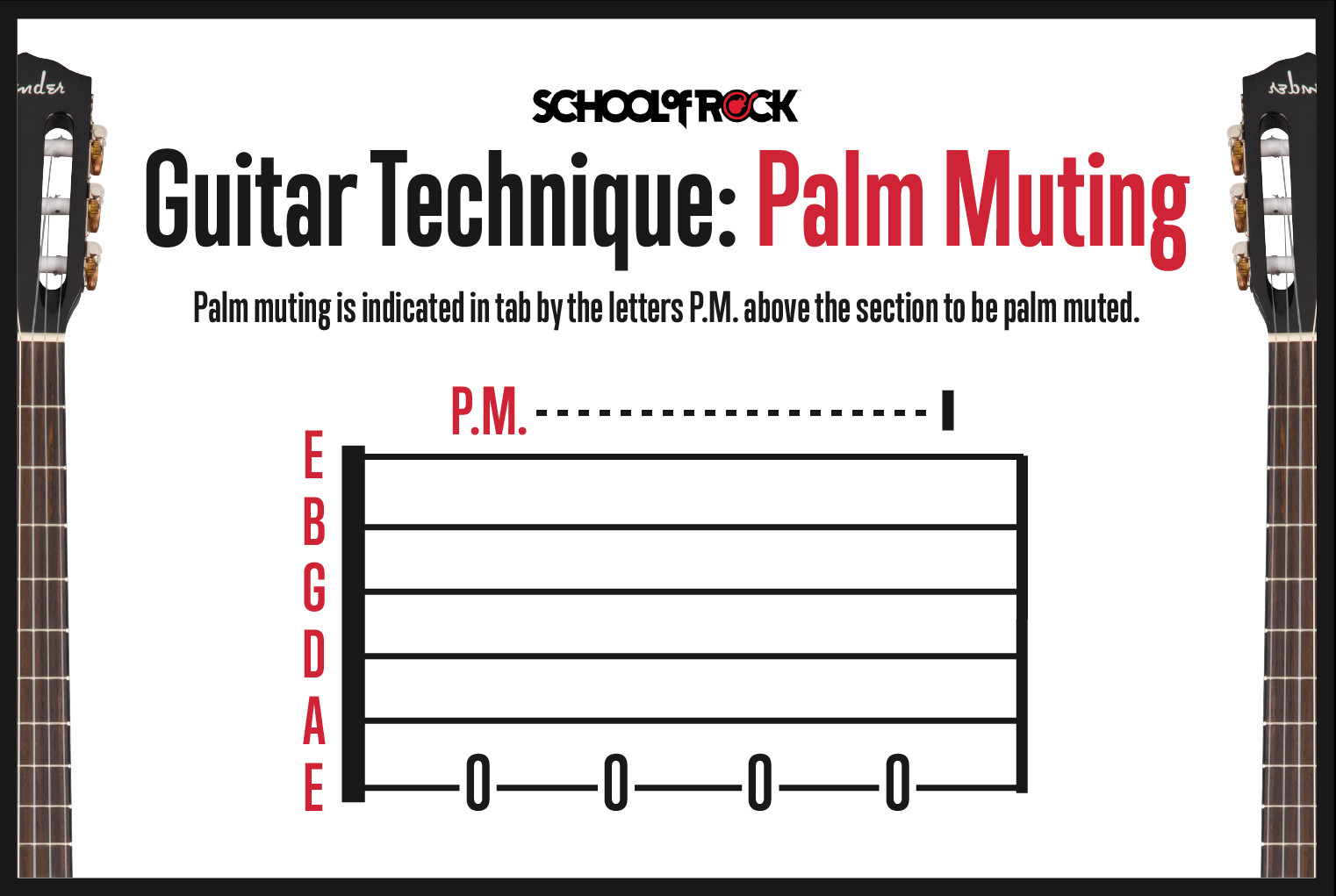 Guitar technique palm muting
Guitar technique palm muting
Muted Notes Technique in Guitar Tabs
Muted notes, distinct from palm muting, are achieved using your fretting hand. In this technique, you pick the note, but your fretting hand lightly touches the string without fully pressing it down to the fretboard. This results in a percussive, choked sound. Muted notes are represented in guitar tabs by an “X” in place of a fret number.
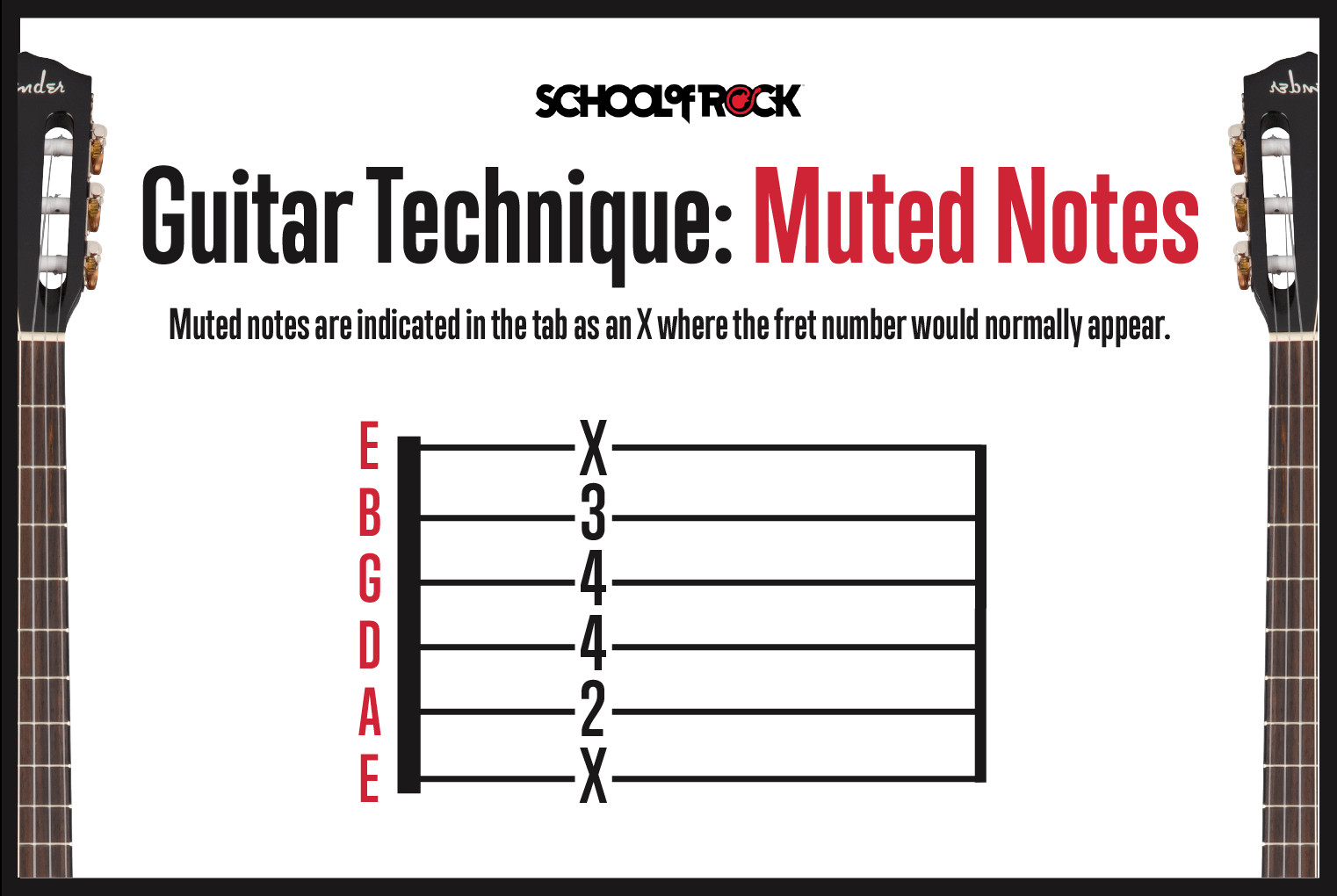 Guitar technique muted notes
Guitar technique muted notes
Bending Guitar Strings: Vocal-like Expression
String bending is a technique that imparts a vocal, expressive quality to guitar playing by altering the pitch of a note. In guitar tabs, bends are indicated by a curved arrow above the note to be bent. The arrow may specify the bend amount, such as “½” for a half step or “full” for a whole step. These target pitches are often referred to as “target notes.”
How to Bend Guitar Strings Effectively
Bending involves pushing or pulling the string sideways across the fretboard, rather than pressing straight down. For most strings (except the low E), you typically push upwards towards the ceiling. The low E string is usually bent downwards towards the floor. The key is to apply smooth, consistent pressure throughout the bend.
Bending Techniques in Guitar Tabs
Most bends are executed using 2 or 3 fingers: the primary fretting finger (often the ring finger) and the middle and index fingers for support and strength. This multi-finger approach facilitates smoother, more controlled bends and accurate pitch.
 Guitar technique bending strings
Guitar technique bending strings
Pre-bending Technique in Guitar Tabs
Beginners learning guitar tabs may encounter “pre-bends.” A pre-bend involves bending the string before picking it, then picking the bent note and sometimes releasing the bend back to the original pitch. Pre-bends are shown in tabs with an upward arrow indicating the bend amount (full, ½, etc.), followed by a curved downward arrow indicating the release. Pre-bent notes may return to the original pitch or bend further to another target note.
Sliding Guitar Notes: Smooth Transitions
Sliding is another technique for transitioning between notes smoothly. You slide your fretting finger along the string from one fret to another, either upwards (towards the headstock) or downwards (towards the body).
Slide Up Technique in Guitar Tabs
A slide up is represented in guitar tabs by a line connecting the starting note and the higher target note. The line often slants slightly upwards to visually indicate an upward slide.
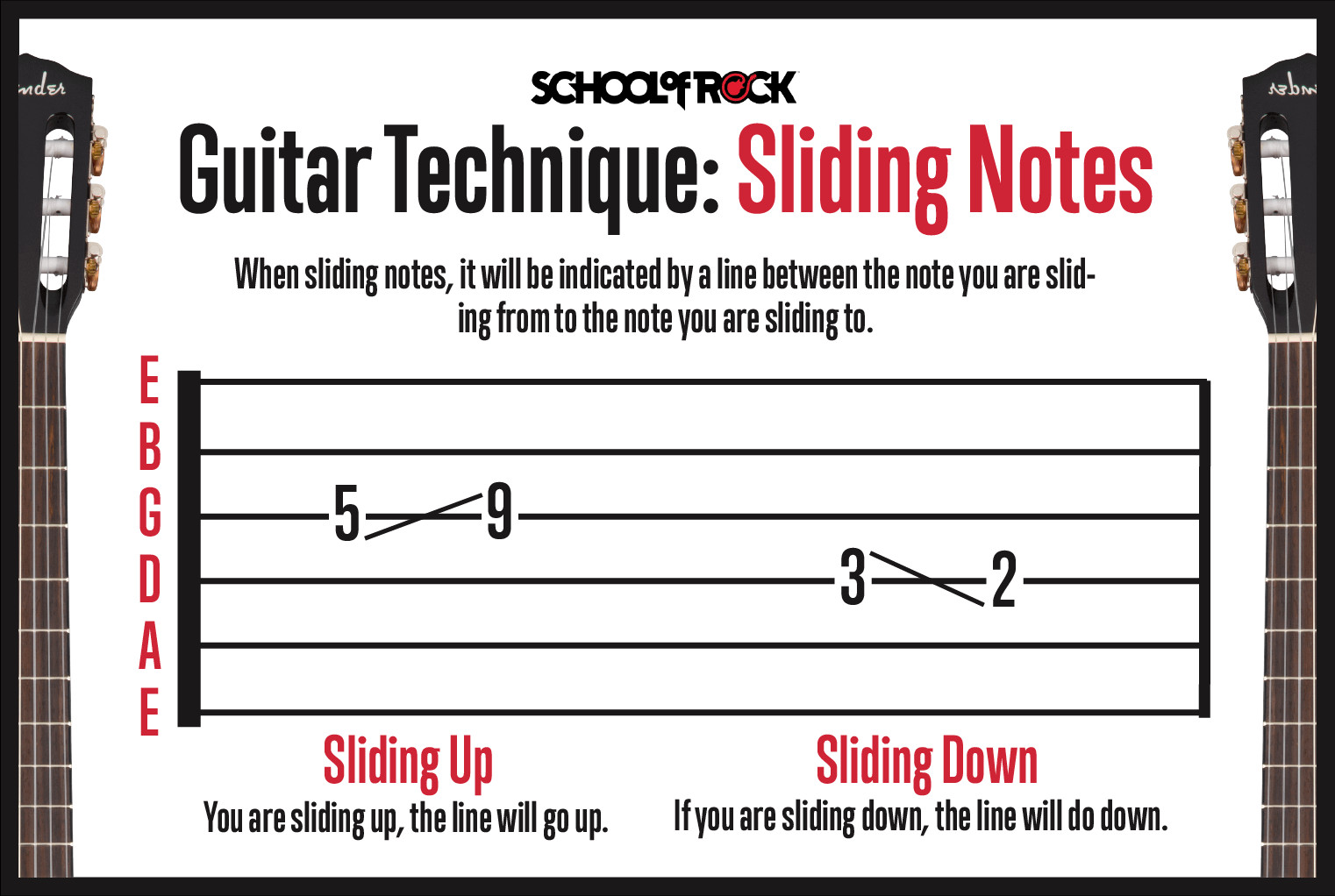 Guitar technique sliding notes
Guitar technique sliding notes
Slide Down Technique in Guitar Tabs
Conversely, a slide down is depicted by a line connecting the starting note and the lower target note. This line may slant slightly downwards to visually represent a downward slide.
Hammer-Ons: Creating Notes with Fret-Hand Technique
Hammer-ons are a technique where you create a note by “hammering” your fretting finger onto the string behind a fret, without picking the string again. You can hammer-on from an open string or a previously fretted note, resulting in a higher-pitched note. Hammer-ons are indicated in guitar tabs by the letter “H” and an arc connecting the initial note to the hammered-on note.
How to Execute Hammer-Ons
To play a hammer-on, strike the string with your fretting finger with enough force to sound the note clearly. This requires practice to achieve a strong, clean tone. It’s often easier to execute hammer-ons on electric guitars at moderate volume levels. Try starting with the open low E string and hammer-on to the third fret, holding the note to let it ring. Practice this on different strings and frets.
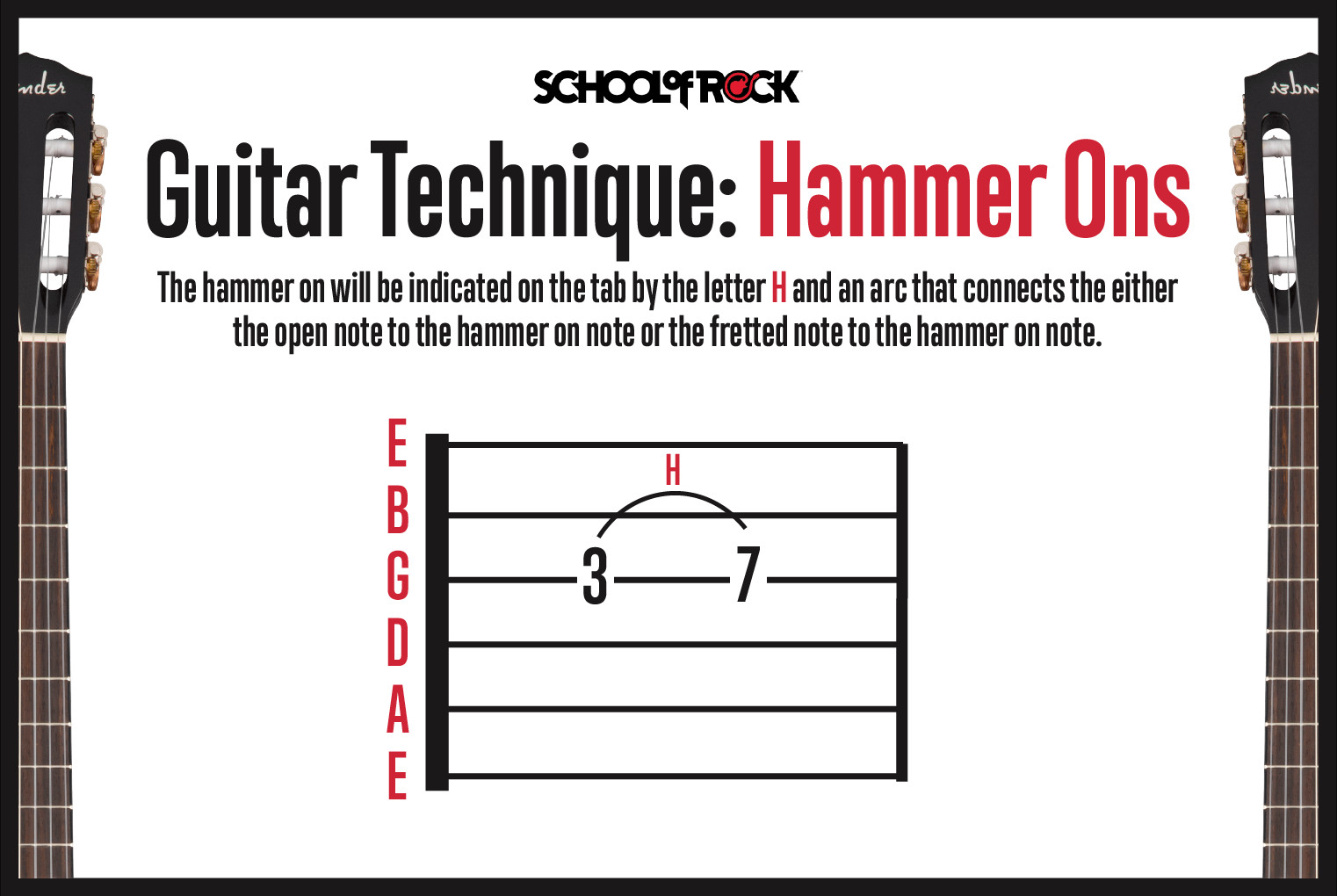 Guitar technique hammer ons
Guitar technique hammer ons
Pull-Offs: The Reverse of Hammer-Ons
Pull-offs are the opposite of hammer-ons. Instead of hammering on, you “pull off” a fretted finger to sound a lower note, either an open string or a note fretted by another finger. Pull-offs are represented in guitar tabs by the letter “P” and an arc connecting the pulled-off note to the resulting lower note.
How to Execute Pull-Offs
To perform a pull-off, fret a note and then pull your finger off the string in a sideways or downward motion, plucking the string as you release. This action should sound a lower note, either an open string or a note fretted on a lower fret. When executing pull-offs, ensure you “grab” enough of the string with your fingertip to produce a clear sound.
Hammer-ons and pull-offs can be combined in alternating sequences, often referred to as “trills,” by repeatedly hammering-on and pulling-off.
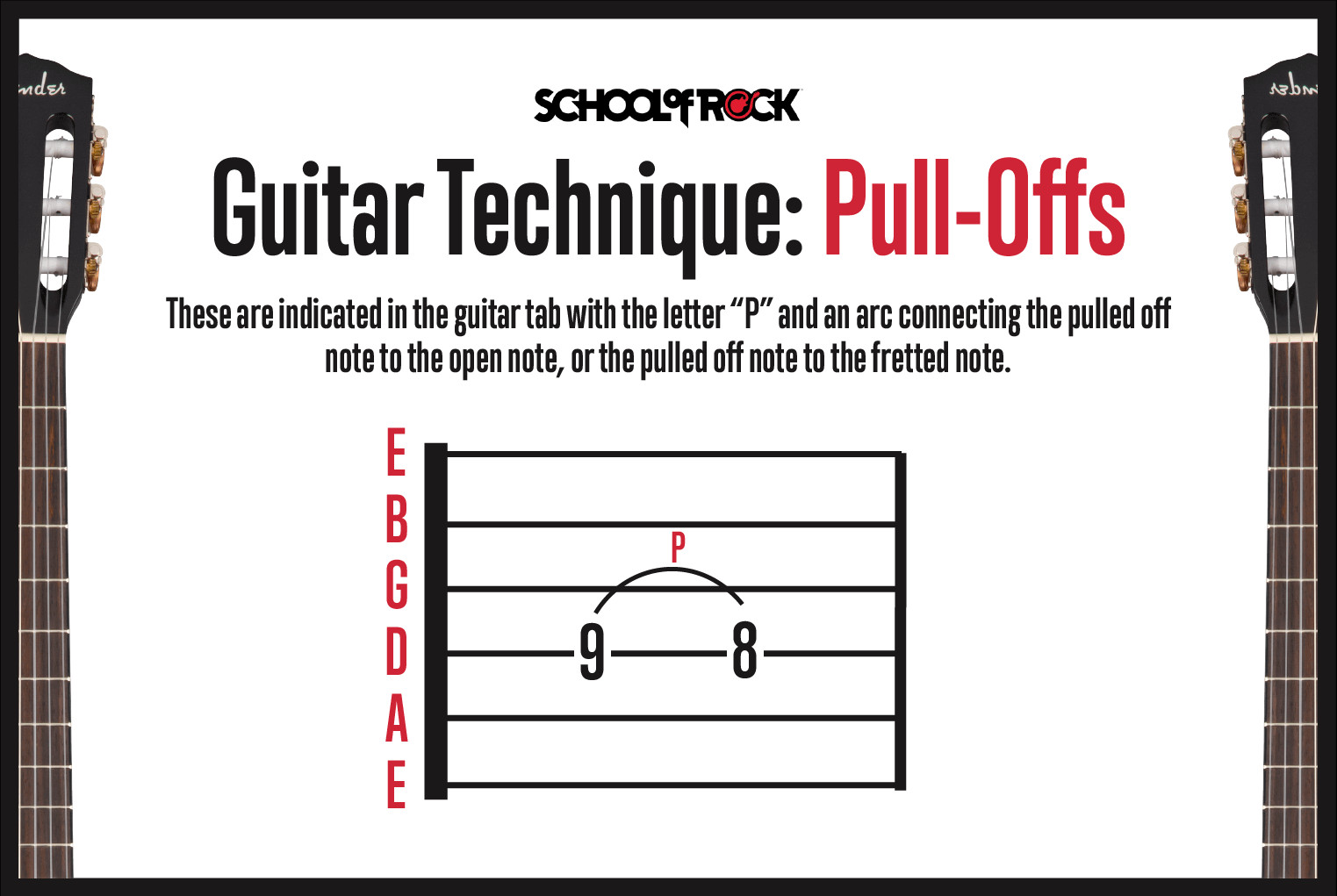 Guitar technique pull offs
Guitar technique pull offs
Vibrato: Adding Emotion and Sustain
Vibrato is a technique that adds sustain and emotional depth to notes by repeatedly and subtly bending and releasing the string around its original pitch without fully releasing the note. Vibrato is shown in guitar tabs as a zig-zag line above the staff. The length of the zig-zag line often indicates the duration of the vibrato.
How to Apply Vibrato
Vibrato is similar to bending but with a smaller pitch variation and a rhythmic oscillation. You can apply vibrato using a single finger or by using a main finger with supporting fingers for added control. Start practicing with a slow, smooth vibrato and then vary the speed for different expressive effects. Like bending, vibrato is a highly personal technique, and each guitarist develops a unique vibrato style.
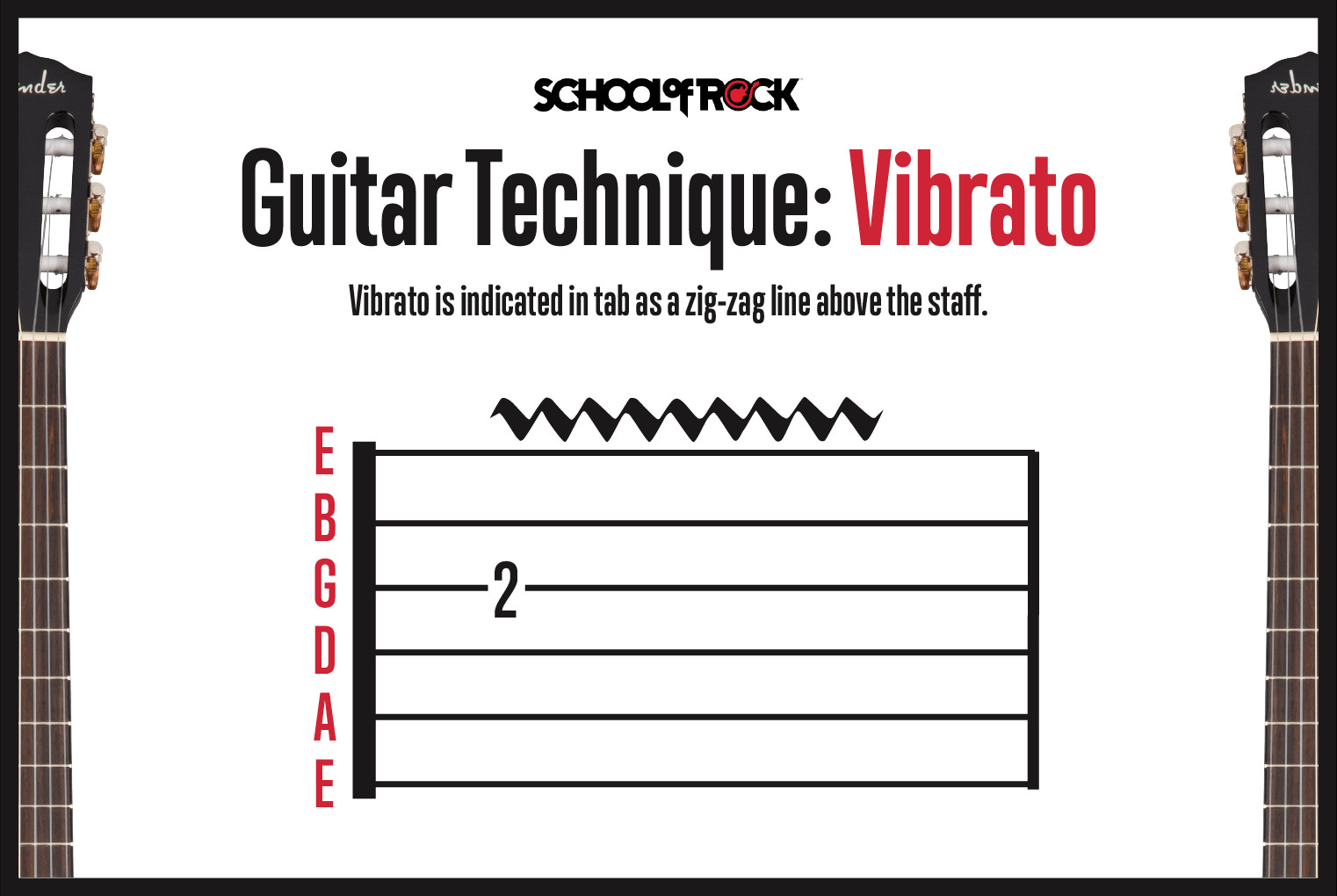 Guitar technique vibrato
Guitar technique vibrato
Tapping: Two-Handed Fretboard Freedom
Tapping is an advanced technique involving using both hands to fret notes on the fretboard. Your regular fretting hand frets notes as usual, while your picking hand “taps” or hammers-on notes, typically with the index finger. Picking-hand tapping is a variation of the hammer-on technique. Tapping is notated in guitar tabs by the letter “T” above the tapped note.
How to Finger Tap
Tapping was popularized by Eddie Van Halen but has roots in classical guitar. To finger tap, fret a note with your fretting hand and then tap a higher note on the same string with your picking hand’s index finger.
Finger tapping extends the reach of your playing hand, allowing for wide intervals and rapid note sequences that are difficult or impossible with standard fretting techniques alone. Using overdrive or distortion and a moderate volume level often enhances the clarity and sustain of tapped notes. Tapping enables very fast playing because both hands are actively fretting notes.
 Guitar technique tapping notes
Guitar technique tapping notes
Two-Handed Tapping Technique
Two-handed tapping takes the technique further, where both hands independently tap notes on the fretboard without traditional picking. This can involve the fretting hand tapping bass notes while the picking hand taps melody or solo lines, creating complex and layered textures.
Strumming Guitar Notes: Rhythm and Groove
When strumming chords, two basic strumming directions are used: downstrokes and upstrokes.
Downstrokes are played from the thicker, lower strings to the thinner, higher strings using a downward motion. In guitar tabs, downstrokes are represented by a symbol resembling a thick horizontal line with two short vertical “legs” pointing downwards on either side.
Upstrokes are the reverse, played from the higher strings to the lower strings using an upward motion. Upstrokes are notated in guitar tablature by a “V” shaped symbol.
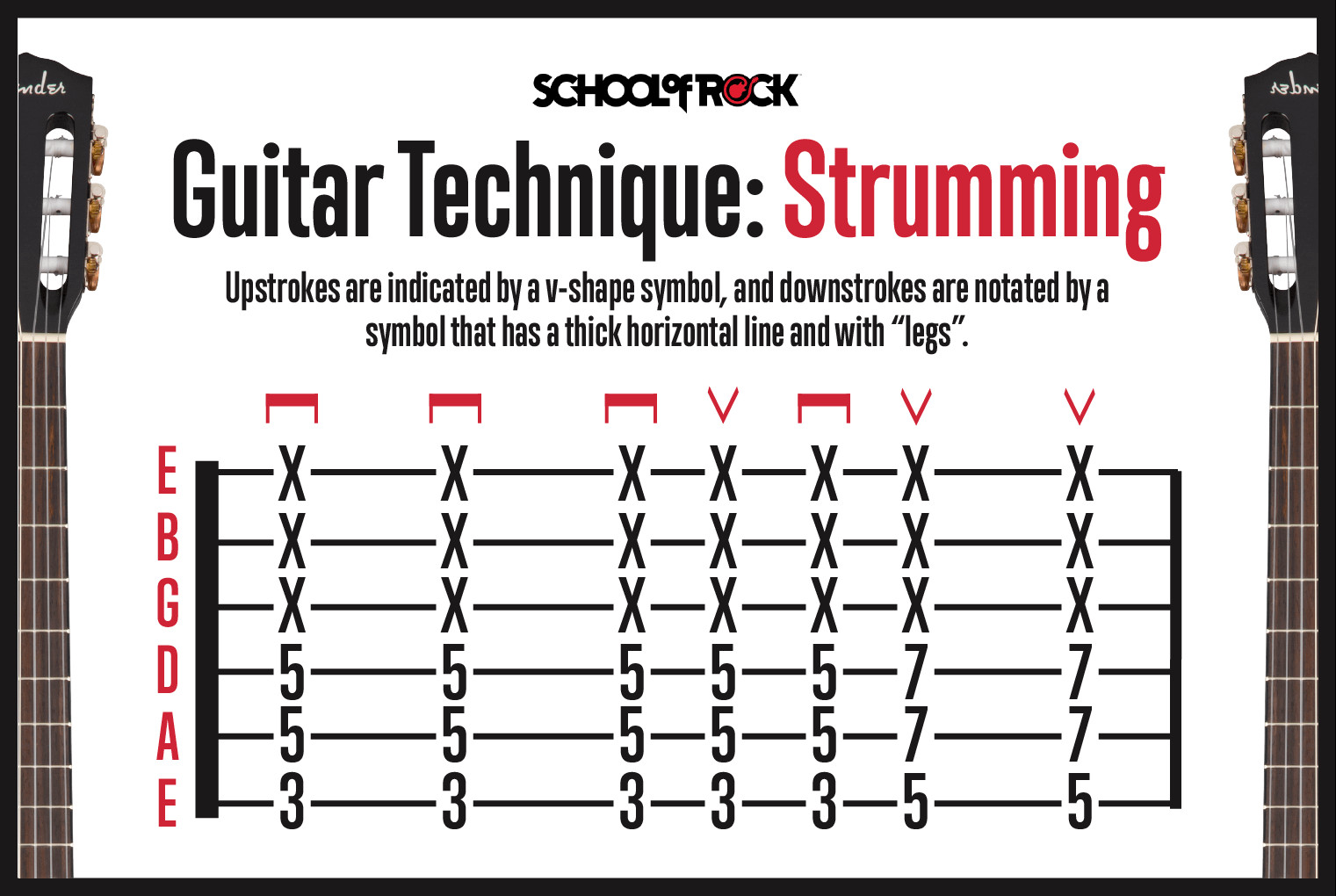 Guitar technique strumming
Guitar technique strumming
How to Strum Rhythms
Strumming patterns vary greatly depending on the song’s rhythm and style. You can use a constant downstroke pattern, an alternating down-up pattern, or more complex combinations. Common rhythms like eighth notes are counted as “1 and 2 and 3 and 4 and.” Many songs utilize alternating downstrokes and upstrokes in an eighth-note rhythm, with downstrokes on the numbered counts (1, 2, 3, 4) and upstrokes on the “ands.”
Downstrokes and Upstrokes for Single Notes
The same downstroke and upstroke symbols are used even when playing single notes in guitar tabs. A downstroke symbol indicates picking the note with a downward motion, while an upstroke symbol indicates picking with an upward motion.
Ready to Explore More Guitar Techniques?
Congratulations! You’ve now grasped the fundamentals of reading guitar tabs and understanding common guitar techniques represented in tablature. You are well-equipped to start learning songs and expanding your guitar skills. From basic strumming to advanced tapping, guitarplayers.net is committed to helping you achieve your musical goals. Our comprehensive resources and expert guidance will empower you to quickly learn your favorite songs and progress on your guitar journey.
Ready to find guitar tabs and start playing? From beginner-friendly tunes to challenging pieces, our website offers a wealth of guitar tabs to explore. Dive in and unleash your musical potential!
Thinking about getting a new guitar? Check out our Guitar Buying Guide

